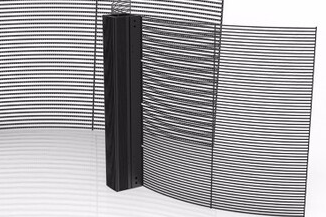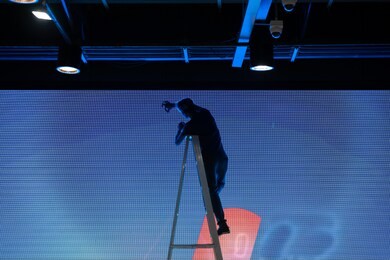Publisher: Supplier of LED Display Time: 2022-12-14 13:47 Views: 2914
If the LED display fails, it will definitely cause trouble for the industry. But the trouble is to be solved, but how to solve these problems? Today, Liancheng Xiaobian will take you to understand 10 methods of LED display troubleshooting.
1. The display screen does not work, and the green light of the sending card flashes (make it retractable)
a. Cause of failure:
1) The screen is not powered;
2) The network cable is not connected properly;
3) The receiving card has no power supply or the power supply voltage is too low;
4) The sending card is broken;
5) The signal transmission intermediate equipment is connected or faulty (such as: function card, optical fiber transceiver box);

b. Troubleshooting method:
1) Check to confirm that the power supply of the screen is normal;
2) Check and reconnect the network cable;
3) Make sure that the DC output power supply of the power supply is at 5-5.2V;
4) Replace the sending card;
5) Check the connection or replace the function card (fiber optic transceiver box);
2. The display screen does not work, and the green light of the sending card does not flash
a. Cause of failure:
1) The DVI or HDMI cable is not connected properly;
2) The copy or expansion mode is not set in the graphics card control panel;
3) The software chooses to turn off the power of the large screen;
4) The sending card is not inserted in place or there is a problem with the sending card;
b. Troubleshooting method:
1) Check the DVI cable connector;
2) Reset the copy mode;
3) The software chooses to turn on the power of the large screen;
4) Reinsert the sending card or replace the sending card;
3. When starting up, it prompts "the big screen system is not found"
a. Cause of failure:
1) The serial cable or USB cable is not connected to the sending card;
2) The COM or USB port of the computer is broken;
3) The serial cable or USB cable is broken;
4) The sending card is broken;
5) The USB driver is not installed.
b. Troubleshooting method:
1) Confirm and connect the serial cable;
2) Replace the computer;
3) Replace the serial cable;
4) Replace the sending card;
5) Install the new software or install the USB driver separately.
4. The long strip with the same height as the light panel does not display or part of it does not display, lack of color
a. Cause of failure:
1) The flat cable or DVI cable (applicable to submarine series) is not in good contact or disconnected;
2) There is a problem with the output of the former display panel or the input of the latter at the junction.
b. Troubleshooting method:
1) Reinsert or replace the cable;
2) First determine which display module is faulty and then replace it for maintenance.
5. Some modules (3-6 blocks) are not displayed
a. Cause of failure:
1) Power protection or damage;
2) The AC power cord is not in good contact.
b. Troubleshooting method:
1) Check to confirm that the power supply is normal;
2) Reconnect the power cord.
6. The whole box is not displayed
a. Cause of failure:
1) The 220V power supply line is not connected properly;
2) There is a problem with the transmission of the network cable;
3) The receiving card is damaged;
4) The HUB board is misplaced;
b. Troubleshooting method:
1) Check the power supply line;
2) Confirm to replace the network cable;
3) Replace the receiving card;
4) Insert the HUB again.
7. the whole screen dots, pictures and shadows move
a. Cause of failure:
1) The driver loader is wrong;
2) The network cable between the computer and the screen is too long or the quality is not good;
3) The sending card is broken;
b. Troubleshooting method:
1) Re-operate to load the receiving card file;
2) Shorten the length of the network cable or replace it;
3) Replace the sending card.
8. Each display unit of the entire display screen displays the same content
a. Cause of failure:
Display connection file not sent.
b. Troubleshooting method:
Reset the sending screen file, and plug the network cable connected to the computer into the output port of the sending card near the indicator light when sending.
9. The brightness of the display screen is very low, and the display image is blurred
a. Cause of failure:
1) The sending card program is wrong;
2) The setting of the function card is incorrect.
b. Troubleshooting method:
1) Restore the default setting of the sending card and save it;
2) Set the minimum monitor brightness value of the display screen to be above 80.
10. Shaking or ghosting of the whole screen
a. Cause of failure:
1) Check the communication line between the computer and the large screen;
2) Check the DVI cable between the multimedia card and the sending card;
3) The sending card is broken.
b. Troubleshooting method:
1) Reinsert or replace the communication line;
2) Reinforce the DVI cable;
3) Replace the sending card.
The above are the common faults and emergency solutions of LED display screens compiled by Liancheng Xiaobian for you. If you are familiar with the common faults and emergency solutions of these ten LED display screens, you don’t have to worry too much about the temporary faults of the display screen, because you are completely Can be solved. Lianchengfa (LCF) is a national-level professional and new "little giant" enterprise, a LED display application and solution provider integrating "hardware + software + content + interaction". The main business covers four major sections: "Smart City", "Cultural Tourism Commercial Performance", "Commercial Display Engineering", and "Content Technology". It has the world's leading automated production equipment, modern post-doctoral research laboratories and comprehensive sales and services. team. Friends who want to buy LED displays can also contact us Lianchengfa led display manufacturer, a big country brand, trustworthy!









